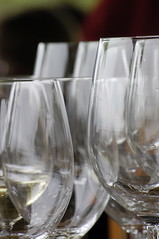Wine: Coeur d’Alene Cellars Viognier
Apparently Viognier does not read this blog. Not that it should, necessarily, but seriously, the Coeur d'Alene Cellars approach in 2003 was exactly what I was complaining about: the "Idaho wine" (quotes due to the fact that its grapes come from the state of Washington) is a no-holds-barred, fully mechanized cream assault. Folks talked of apricots as they do on their website, but frankly I was underwhelmed with the overly vegetative smell.
Yikes. A friend paid too much for it at a vegetarian restaurant which will go unnamed (oops); the restaurant described it as spicy and pointed out with glee that it must be unfiltered because it's so cloudy. Sorry, it's not just unfiltered: it's flawed.
Which gets me thinking about wine contests in general. What does it mean for an Idaho wine, made entirely from Washington's grapes, that can dismay me so much to win a gold prize in an Idaho contest? (Lest you think I am making too much of the state distinction, these grapes are travelling around 200 miles on average.) Perhaps it's best not to think of things about which you have nothing nice to say.
But maybe this blog has earned at least the right to complain a little bit; there isn't too much negative here. Wine contests are bizarre and especially confusing for the average consumer in part because of their large catalog of categories. For example, one such contest has six (6) categories for varying levels of residual sugar; if you don't like dry or cloyingly sweet wines and a particular wine hoists a gold medal, what does that mean, exactly? I have yet to see a wine bottle explain exactly what it won, and in which category. I especially get a kick out of the fact that most competitions are done with more than one judge; an average of varying tastes doesn't tell you much apart from an indication that a wine may not be grotesquely flawed in its hilariously obscure category. (It doesn't always bother me to be a kettle calling the pot black.)
And there's another thing, too, that's hard: picking on someone just becase you don't like their style. But hey, I don't. (Only a wine so overly oaked can force me to use the word 'but' as a sentence starter so often. My grade school English teachers, wrong though they were on this particular topic, would beat me with a stick.) I fail to see how a casual wine drinker could find a difference between this ~$20 Viognier and a cheap, overoaked Chardonnay.
Value: 0.5
Color & Clarity: 1.0
Bouquet: 2.0
Flavor: 1.0
Yikes. A friend paid too much for it at a vegetarian restaurant which will go unnamed (oops); the restaurant described it as spicy and pointed out with glee that it must be unfiltered because it's so cloudy. Sorry, it's not just unfiltered: it's flawed.
Which gets me thinking about wine contests in general. What does it mean for an Idaho wine, made entirely from Washington's grapes, that can dismay me so much to win a gold prize in an Idaho contest? (Lest you think I am making too much of the state distinction, these grapes are travelling around 200 miles on average.) Perhaps it's best not to think of things about which you have nothing nice to say.
But maybe this blog has earned at least the right to complain a little bit; there isn't too much negative here. Wine contests are bizarre and especially confusing for the average consumer in part because of their large catalog of categories. For example, one such contest has six (6) categories for varying levels of residual sugar; if you don't like dry or cloyingly sweet wines and a particular wine hoists a gold medal, what does that mean, exactly? I have yet to see a wine bottle explain exactly what it won, and in which category. I especially get a kick out of the fact that most competitions are done with more than one judge; an average of varying tastes doesn't tell you much apart from an indication that a wine may not be grotesquely flawed in its hilariously obscure category. (It doesn't always bother me to be a kettle calling the pot black.)
And there's another thing, too, that's hard: picking on someone just becase you don't like their style. But hey, I don't. (Only a wine so overly oaked can force me to use the word 'but' as a sentence starter so often. My grade school English teachers, wrong though they were on this particular topic, would beat me with a stick.) I fail to see how a casual wine drinker could find a difference between this ~$20 Viognier and a cheap, overoaked Chardonnay.
Value: 0.5
Color & Clarity: 1.0
Bouquet: 2.0
Flavor: 1.0


















